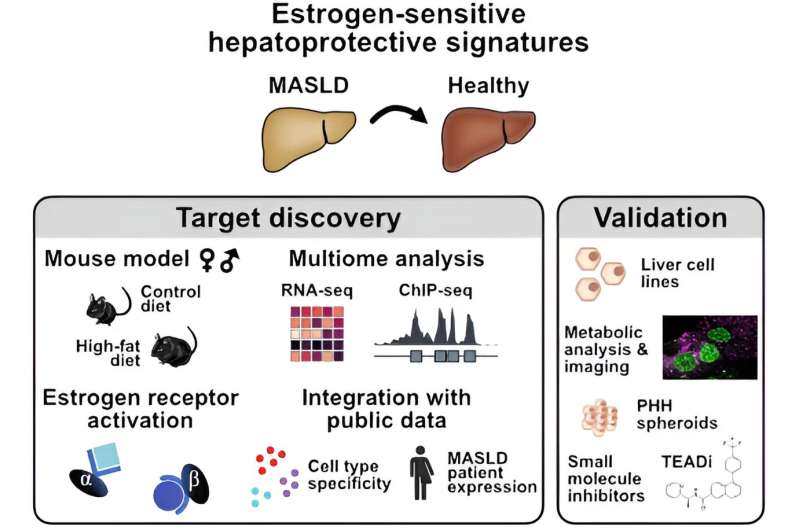This article has been reviewed according to Science X's editorial process and policies. Editors have highlighted the following attributes while ensuring the content's credibility:
fact-checked
trusted source
proofread
Study shows how estrogen protects against fatty liver

New research from Karolinska Institutet shows how estrogen protects against MASLD, a fatty liver disease that has increased dramatically during the current obesity epidemic. The study, published in Molecular Systems Biology, shows how a new drug under development could become a future treatment for fatty liver disease and liver cancer.
The global obesity epidemic has resulted in a dramatic increase in fatty liver, a disease in which fat that does not fit into fat cells is stored in liver cells instead.
Since last year, fatty liver due to obesity (and not excessive alcohol consumption) is known as MASLD (metabolic dysfunction-associated steatotic liver disease). According to previous research, as many as one in three adults are affected by some degree of MASLD, which in the worst cases can develop into cirrhosis and liver cancer.
Women protected until menopause
However, the disease is very unevenly distributed between the sexes, with a large majority of affected individuals being men.
"Women have a natural protection until menopause due to the female sex hormone estrogen," explains Claudia Kutter, senior researcher at the Department of Microbiology, Tumor and Cell Biology, Karolinska Institutet who led the study.
Although women's protection has been known for some time, the mechanism behind the protective effect has been less clear. Now Kutter's research team may have found the answer.
Through genetic analyses of mice of both sexes fed a high-fat diet, with some of the male mice also receiving estrogen, the researchers were able to identify a key protein in the development of fatty liver.
The protein, called TEAD1, was found to play an overall role in regulating how liver cells absorb fat. Blocking TEAD1 protected liver cells from the harmful accumulation of fat. Mice receiving estrogen treatment had lower TEAD1 activity and less fat accumulation in the liver.
New drug under development
In the next step, the researchers tested blocking TEAD1 in human liver cells with the same result. The fact that this was possible at all, however, was a bit of luck.
"It turned out that a pharmaceutical company is developing an anti-cancer drug that blocks TEAD1, which allowed us to test our hypothesis," says Kutter.
The fact that TEAD1 is also involved in cancer does not worry her, quite the contrary.
"Since the activity of TEAD proteins is elevated in cancer, blocking TEAD at an early stage can also be positive from a cancer point of view," she says. "Patients suffering from liver cancer are currently diagnosed very late. If the patient is given this drug early in the process to protect against fatty liver, it can hopefully also prevent the development of liver cancer."
The pharmaceutical company will now start clinical trials of the drug as a protection against fatty liver disease, while Kutter's research team will continue researching further ways to tackle the disease.
"We want to focus on how to find the disease earlier and identifying new treatment targets," she says. "Different approaches may be needed for different patients depending on their gender and hormonal status."
More information: Christian Sommerauer et al, Estrogen receptor activation remodels TEAD1 gene expression to alleviate hepatic steatosis, Molecular Systems Biology (2024). DOI: 10.1038/s44320-024-00024-x




















